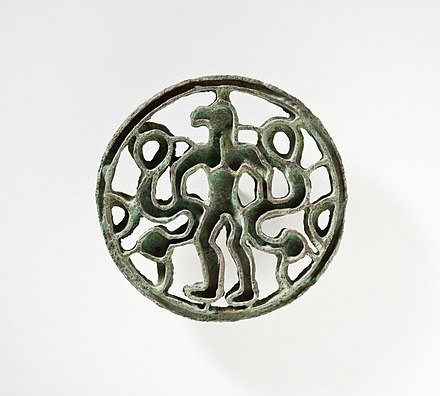-
-
Notifications
You must be signed in to change notification settings - Fork 3
Oxus
Afanasievo were an early PIE 3300BC eneolithic steppe culture with ⋍100% haplogroup R1b.
The agricultural Oxus Civilization which peaked 2400-1900 BC had a different genetic setup:
E1b1a 1/18, E1b1b 1/18, G 2/18, J* 2/18, J1 1/18, J2 4/18, L 2/18, R* 1/18, R1b 1/18, R2 2/18, and T 1/18. Highly admixtured with ancient/'near east' populations (natufian:E1b1b semitic:J…).
Oxus Civilization ⋍ Bactria–Margiana Archaeological Complex BMAC
Marguš, the capital of which was Merv Mary/Gonur
Bactria > Box > Ox (⋍Bull) vs Taur
Upper Amu Darya (Oxus River):
Afghanistan, eastern Turkmenistan, southern Uzbekistan and western Tajikistan
mud brick houses were first occupied c. 7200 BC
goats and sheep and grew wheat and barley
distinct break in settlement history between the late neolithic and early chalcolithic eras there
irrigation crop hexaploid bread wheat became predominant during the Chalcolithic period.
Models of two-wheeled carts from c. 3000 BC found at Altyn-Depe are the earliest complete evidence of wheeled transport in Central Asia, pulled by oxen. camels were domesticated within the BMAC.
no oxus paradise
in prehistoric southern Turkmenistan, rain-fed cultivation of cereals was impossible, as it is at present. for p. dolukhanov (1981: 375) the seasonal moisture regime of the Neolithic and Chalcolithic periods did not differ significantly from that of today, even if in the past annual precipitation was greater and spring floods more substantial. The earliest cultivators of the djeitun Neolithic (c. 6000–5000 Bc) depended on irrigation and/or groundwater in order to ripen the crops. intensive research at djeitun (lisizyna 1965, 1969, 1978; harris and gosden 1996; harris et al. 1996; harris 2010) confirmed this hypothesis.
Writing: Anau seal five markings which are similar to Chinese "small seal" characters

The only match to the Anau seal is a small jet seal of almost identical shape from Niyä (near modern Minfeng) along the southern Silk Road in Xinjiang, originally thought to be from the Western Han dynasty but now thought to date to 700 BC. The only other known jet-(pitch coal)-seals come from Maykop!
About 1800 BC, the walled BMAC centres decreased sharply in size. Each oasis developed its own types of pottery and other objects. (break down of 'state') Tazabagyab remains resemble those of the nomads of the Andronovo culture. Kurgan cemeteries of the Bishkent type appeared with pottery that mixed elements.
The relationship between Altyn-Depe and the Indus Valley seems to have been particularly strong.
There is evidence of sustained contact between the BMAC and the Eurasian steppes to the north, intensifying c. 2000 BC.
Bactria–Margiana material has been found at Susa. BMAC material is subsequently found further to the south in Iran, Afghanistan, Nepal, India and Pakistan, the subsequent movement of Indo-Iranian-speakers 'after they had adopted the culture of the BMAC'.
The male specimens belonged to haplogroup E1b1a (1/18), E1b1b (1/18), G (2/18), J* (2/18), J1 (1/18), J2 (4/18), L (2/18), R* (1/18), R1b (1/18), R2 (2/18), and T (1/18).
See Andronovo / Afanasevo
See Mergar/Mehrghar for Harappan civilization, Turk/Tocharian at Tarim basin and China
Tarim Mummies surprisingly found to be Holocene ANE relics with (near) zero influx of BMAC or Afanasievo ancestry!
Home | Alphabet | Grammar | Gardiner-signs
Home
preserved words
PIE
Inventions
Kur
Signs
Keyboard
Dictionary
Swadesh lists
Text Corpus
Axioms
Grammar
Pronouns
Numbers
Highlights
Cosmos
Gothic
Akkadian
determinatives
+
| äЯ | 𓄿 |
|---|---|
| A | 𓂝 |
| b | 𓃀 |
| c | 𓍿 |
| D | 𓏏 |
| δ | 𓂧 |
| E | 𓇋 |
| F | 𓇋𓆑 |
| G | 𓎼𓐍 |
| h | 𓉔 |
| I | 𓇋 |
| J | 𓆓 |
| K | 𓎡𓌨𓐍 |
| L | 𓏯𓃭 |
| M | 𓅓 |
| N | 𓈖 |
| ϱ | 𓍢𓍯 |
| P | 𓊪 |
| Q | 𓏘 |
| R | 𓂋 |
| S | 𓋴 |
| T | 𓏏 𓎀 |
| ṳ | 𓅱𓍢 |
| V | 𓆑 |
| W | 𓅳 |
| X | 𓎛 |
| Y | 𓏭 |
| Z | 𓊃 𓎀 |
| SH | 𓈙 |


